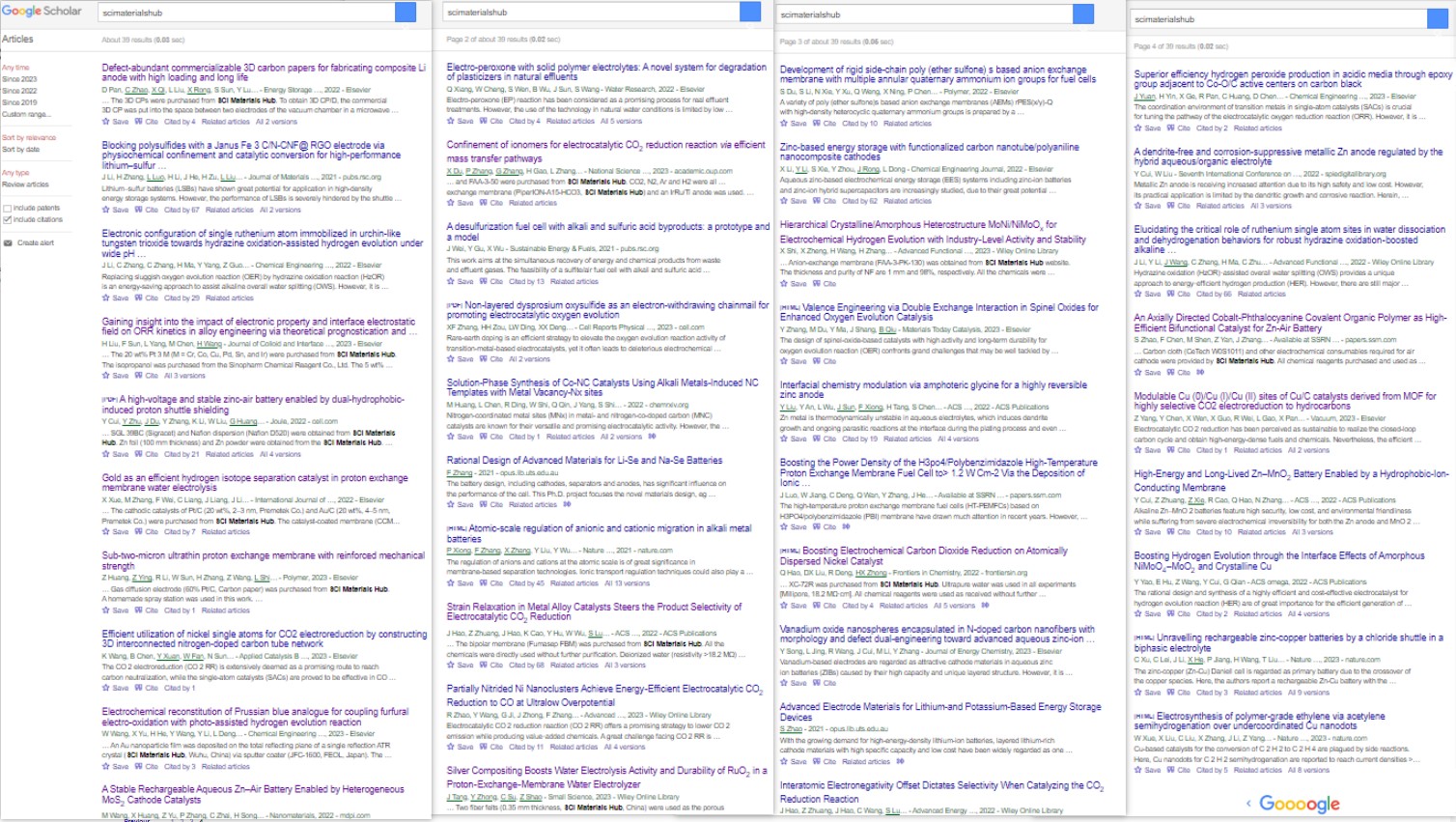
SciMater-JY Research Grade Ti3AlC2 Phase Powder
Titanium aluminum carbide (Ti Al carbide) is a new type of three-layer structure ceramic material, which has attracted extensive attention of material scientists and physicists because of its unique properties.
The SCI Materials Hub produces high-quality Max phase and MXene materials, which are widely used in scientific research.
[if you need to purchase, please click the [Quote & Order] above to obtain price and other purchase information]
Titanium aluminum carbide (Ti3AlC2) belongs to hexagonal system and has the characteristics of metal and ceramic: it not only has the same conductivity and thermal conductivity as metal, but also has the same high elastic modulus and excellent high-temperature mechanical properties as ceramic. It has good conductivity and thermal conductivity, high elastic modulus, low Vickers hardness and good damage resistance. It can be processed at room temperature and produce plastic deformation at high temperature. It also has good high temperature stability and oxidation resistance. It also has good thermal shock resistance, damage resistance and excellent chemical corrosion resistance.
Max phase ceramics (including Ti3SiC2, Ti3AlC2, etc.) is a new type of Machinable conductive ceramics. These ceramics contain more than 60 kinds of ternary carbides or nitrides. M represents the pre metallic element of the transition group; A represents the main family elements, mainly the third and fourth groups of elements; X stands for carbon or nitrogen. Ti3SiC2 is the most widely studied. In 1996, Professor barsum m of Drexel University successfully synthesized Ti3SiC2 by hot pressing, and found its excellent properties. Due to its unique nano layered crystal structure, this ceramic material has the properties of oxidation resistance, self lubrication, high fracture toughness and conductivity at room temperature. This material can be widely used as high-temperature structural material, electrode brush material, chemical anti-corrosion material and high-temperature heater. The products are mainly used for high-temperature coatings, mxene precursors, conductive self-lubricating ceramics, lithium-ion batteries, supercapacitors, electrochemical catalysis, etc.
English Name: titanium aluminum carbide
CAS:196506-01-1
Product Description: titanium aluminum carbide ceramic powder is prepared by sintering the mixture of Ti, Al and C powder by high temperature plasma, and then mechanical crushing and inert gas grinding.
Intended use: for the preparation of mxenes by chemical etching, which is required by physical chemistry experiment and scientific research;
Essential information:
1. Chemical formula: Ti3AlC2
2. Constituent elements: Ti, Al, C
3. Relative molecular weight: 194.6
4. Chemical state: micro nano particles
5. Appearance and properties: dark brown particles with micro nano size
Product performance index:
1. Crystal structure: hexagonal, p63 / MMC [194]
2. Cell parameters:
a=3.081 A,b=3.081 A,c=18.679 A;
α= 90.00°, β= 90.00°, γ= 120.00°;
3. PDF No.: jcpds No. 52-0875 (refer to the pdf-2004 database of the international diffraction data center);
4. Density: 4.2 (g/cm3);
5. Boiling point: ≥ 2700 ℃;
6. Melting point: ≥ 1300 ℃;
Storage conditions and validity period
This product should be stored in a dry place away from light at room temperature to avoid contact with acid, alkali and other liquids. Slow oxidation will occur after long-term storage.
Inspection method
The crystal results of this product can be confirmed by X-ray powder diffractometer; Confirm the element composition by energy dispersive X-ray detector; The particle morphology was characterized by the same morphology characterization; And laser particle size analyzer to evaluate the particle size distribution.
Safety protection
1. Health hazards
Hazard category: non hazardous chemicals chemical category: ceramic powder; Invasion route: inhalation and ingestion; Health hazards: dust is irritating to the eyes, and oral administration stimulates the gastrointestinal tract;
2. First aid measures
Skin contact: take off the contaminated clothes and wash the skin thoroughly with flowing water; Eye contact: lift the eyelids and rinse with a large amount of flowing water or normal saline for at least 15 minutes; Inhalation: quickly leave the site to a place with fresh air; Ingestion: drink enough warm water, induce vomiting and seek medical advice.
3. Combustion and explosion characteristics and fire protection
Flammability: non flammable
For international orders, please ask us for quotes via
Email: contact@scimaterials.cn
Tel: +86 15375698751
Wechat: SCI-Materials-Hub
Clik here to put quick orders on our Alibaba shop
SciMater-JY Research Grade Ti3AlC2 Phase Powder | ||||
Product Code | Retail Price (USD$) | Lead Time | ||
| 200 mesh | ?400 mesh | 600 mesh | ||
SciMater-JY1 Ti3AlC2 MAX Phase (Purity: 98%) | $56 (Item#:31070101-10g) $160 (Item#:31070101-50g) | $92 (Item#:31070102-10g) $190 (Item#:31070102-50g) | $96 (Item#:31070103-10g) $280 (Item#:31070103-50g) | 3-7 days |
SciMater-JY2 High Purity Ti3AlC2 MAX Phase (Purity: 99%) | $176 (Item#:31070104-10g) $740 (Item#:31070104-50g) | $188 (Item#:31070105-10g) $790 (Item#:31070105-50g) | / | 3-7 days |
| SciMater-JY3 Super Purity Ti3AlC2 MAX Phase (Purity: 99.99%) | $196 (Item#:31070107-10g) $780 (Item#:31070107-50g) | $208 (Item#:31070108-10g) $830 (Item#:31070108-50g) | / | 3-7 days |
| SciMater-JY4 Excess Aluminum Ti3AlC2 MAX Phase | $80 (Item#:31070110-5g) $480 (Item#:31070110-50g) | $84 (Item#:31070111-5g) $500 (Item#:31070111-50g) | / | 3-7 days |
We Are Committed to Offering The Best Price & Customer Services! | ||||
SciMater-JY1 Ti3AlC2 MAX Phase:Purity 98%,It is suitable for LiF + HCl method to etch less (single) layers.
SciMater-JY2 High Purity Ti3AlC2 MAX Phase:Purity 99%.
SciMater-JY3 Super Purity Ti3AlC2 MAX Phase:Purity 99.99%,It does not contain impurities and is suitable for etching with any etchant.
Discount on bulk quantities.
Worldwide shipping via DHL, SF-Express & other requested carriers.
Payments via Bank Transfer, Paypal, Credit card (via Alibaba), Alipay, Wechat-pay are accepted.
Partial references citing our materials (from Google Scholar)

Carbon Dioxide Reduction
1. ACS Nano Strain Relaxation in Metal Alloy Catalysts Steers the Product Selectivity of Electrocatalytic CO2 Reduction
The bipolar membrane (Fumasep FBM) in this paper was purchased from SCI Materials Hub, which was used in rechargeable Zn-CO2 battery tests. The authors reported a strain relaxation strategy to determine lattice strains in bimetal MNi alloys (M = Pd, Ag, and Au) and realized an outstanding CO2-to-CO Faradaic efficiency of 96.6% with outstanding activity and durability toward a Zn-CO2 battery.
2. Front. Chem. Boosting Electrochemical Carbon Dioxide Reduction on Atomically Dispersed Nickel Catalyst
In this paper, Vulcan XC-72R was purchased from SCI Materials Hub. Vulcan XC 72R carbon is the most common catalyst support used in the anode and cathode electrodes of Polymer Electrolyte Membrane Fuel Cells (PEMFC), Direct Methanol Fuel Cells (DMFC), Alkaline Fuel Cells (AFC), Microbial Fuel Cells (MFC), Phosphoric Acid Fuel Cells (PAFC), and many more!
3. Adv. Mater. Partially Nitrided Ni Nanoclusters Achieve Energy-Efficient Electrocatalytic CO2 Reduction to CO at Ultralow Overpotential
An AEM membrane (Sustainion X37-50 Grade RT, purchased from SCI Materials Hub) was activated in 1 M KOH for 24 h, washed with ultra-purity water prior to use.
4. Adv. Funct. Mater. Nanoconfined Molecular Catalysts in Integrated Gas Diffusion Electrodes for High-Current-Density CO2 Electroreduction
In this paper (Supporting Information), an anion exchanged membrane (Fumasep FAB-PK-130 obtained from SCI Materials Hub (www.scimaterials.cn)) was used to separate the catholyte and anolyte chambers.
SCI Materials Hub: we also recommend our Fumasep FAB-PK-75 for the use in a flow cell.
5. Appl. Catal. B Efficient utilization of nickel single atoms for CO2 electroreduction by constructing 3D interconnected nitrogen-doped carbon tube network
In this paper, the Nafion 117 membrane was obtained from SCI Materials Hub.
In this paper, Proton exchange membrane (Nafion 117), Nafion D520, and Toray 060 carbon paper were purchased from SCI Materials Hub.
7. National Science Review Confinement of ionomer for electrocatalytic CO2 reduction reaction via efficient mass transfer pathways
An anion exchange membrane (PiperION-A15-HCO3) was obtained from SCI Materials Hub.
8. Catalysis Communications Facilitating CO2 electroreduction to C2H4 through facile regulating {100} & {111} grain boundary of Cu2O
Carbon paper (TGPH060), membrane solution (Nafion D520), and ionic membrane (Nafion N117) were obtained from Wuhu Eryi Material Technology Co., Ltd (a company under SCI Materials Hub).
Batteries
1. J. Mater. Chem. A Blocking polysulfides with a Janus Fe3C/N-CNF@RGO electrode via physiochemical confinement and catalytic conversion for high-performance lithium–sulfur batteries
Graphene oxide (GO) in this paper was obtained from SCI Materials Hub. The authors introduced a Janus Fe3C/N-CNF@RGO electrode consisting of 1D Fe3C decorated N-doped carbon nanofibers (Fe3C/N-CNFs) side and 2D reduced graphene oxide (RGO) side as the free-standing carrier of Li2S6 catholyte to improve the overall electrochemical performance of Li-S batteries.
This paper used more than 10 kinds of materials from SCI Materials Hub and the authors gave detailed properity comparsion.
The commercial IEMs of Fumasep FAB-PK-130 and Nafion N117 were obtained from SCI Materials Hub.
Gas diffusion layers of GDL340 (CeTech) and SGL39BC (Sigracet) and Nafion dispersion (Nafion D520) were obtained from SCI Materials Hub.
Zn foil (100 mm thickness) and Zn powder were obtained from the SCI Materials Hub.
Commercial 20% Pt/C, 40% Pt/C and IrO2 catalysts were also obtained from SCI Materials Hub.
3. Journal of Energy Chemistry Vanadium oxide nanospheres encapsulated in N-doped carbon nanofibers with morphology and defect dual-engineering toward advanced aqueous zinc-ion batteries
In this paper, carbon cloth (W0S1011) was obtained from SCI Materials Hub. The flexible carbon cloth matrix guaranteed the stabilization of the electrode and improved the conductivity of the cathode.
4. Energy Storage Materials Defect-abundant commercializable 3D carbon papers for fabricating composite Li anode with high loading and long life
The 3D carbon paper (TGPH060 raw paper) were purchased from SCI Materials Hub.
5. Nanomaterials A Stable Rechargeable Aqueous Zn–Air Battery Enabled by Heterogeneous MoS2 Cathode Catalysts
Nafion D520 (5 wt%), and carbon paper (GDL340) were received from SCI-Materials-Hub.
Carbon cloth (W0S1011) and other electrochemical consumables required for air cathode were provided by SCI Materials Hub.
Oxygen Reduction Reaction
1. J. Chem. Eng. Superior Efficiency Hydrogen Peroxide Production in Acidic Media through Epoxy Group Adjacent to Co-O/C Active Centers on Carbon Black
In this paper, Vulcan XC 72 carbon black, ion membrane (Nafion N115, 127 μL), Nafion solution (D520, 5 wt%), and carbon paper (AvCarb GDS 2230 and Spectracarb 2050A-1050) were purchased from SCI Materials Hub.
2. Journal of Colloid and Interface Science Gaining insight into the impact of electronic property and interface electrostatic field on ORR kinetics in alloy engineering via theoretical prognostication and experimental validation
The 20 wt% Pt3M (M = Cr, Co, Cu, Pd, Sn, and Ir) were purchased from SCI Materials Hub. This work places emphasis on the kinetics of the ORR concerning Pt3M (M = Cr, Co, Cu, Pd, Sn, and Ir) catalysts, and integrates theoretical prognostication and experimental validation to illuminate the fundamental principles of alloy engineering.
Water Electrolysis
1. International Journal of Hydrogen Energy Gold as an efficient hydrogen isotope separation catalyst in proton exchange membrane water electrolysis
The cathodic catalysts of Pt/C (20 wt%, 2–3 nm) and Au/C (20 wt%, 4–5 nm) were purchased from SCI Materials Hub.
2. Small Science Silver Compositing Boosts Water Electrolysis Activity and Durability of RuO2 in a Proton-Exchange-Membrane Water Electrolyzer
Two fiber felts (0.35 mm thickness, SCI Materials Hub) were used as the porous transport layers at both the cathode and the anode.
3. Advanced Functional Materials Hierarchical Crystalline/Amorphous Heterostructure MoNi/NiMoOx for Electrochemical Hydrogen Evolution with Industry-Level Activity and Stability
Anion-exchange membrane (FAA-3-PK-130) was obtained from SCI Materials Hub website.
Fuel Cells
1. Polymer Sub-two-micron ultrathin proton exchange membrane with reinforced mechanical strength
Gas diffusion electrode (60% Pt/C, Carbon paper) was purchased from SCI Materials Hub.
Characterization
1. Chemical Engineering Journal Electrochemical reconstitution of Prussian blue analogue for coupling furfural electro-oxidation with photo-assisted hydrogen evolution reaction
An Au nanoparticle film was deposited on the total reflecting plane of a single reflection ATR crystal (SCI Materials Hub, Wuhu, China) via sputter coater.

|
We Provide A Broad Range of Materials, Instruments & Solutions in Advanced Science and Technologies | About Us |



